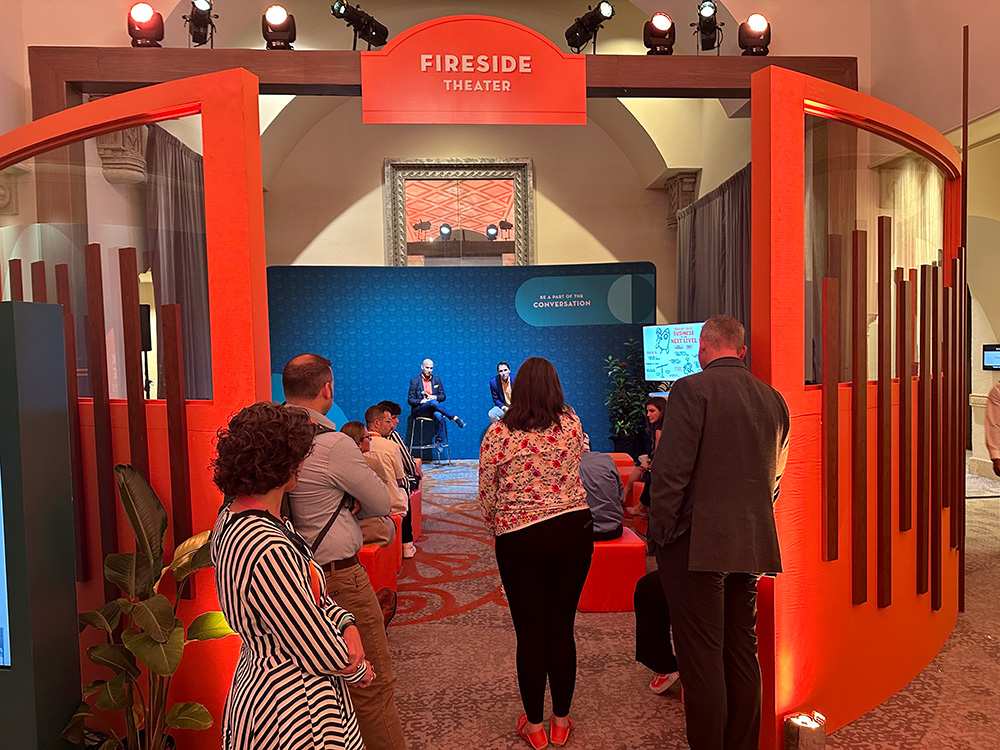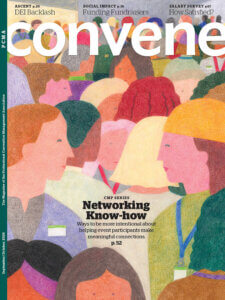
One of the most successful elements at Avalara’s FUSE conference was The Fireside Theater, where guests and FUSE presenters engaged in intimate conversations.
In a recent nearly 40-minute conversation I had with Creative Director Bianca Ferrer about FUSE — a three-day partner conference her Houston-based company, madpot creative, designed last year for the software company Avalara — the word “networking” didn’t come up once.
It reminded me of what Ken Holsinger, Freeman’s senior vice president, strategy, told me earlier this year about designing for relationship-building at events: “If you have to put the word ‘networking’ on it, you’re probably not doing it right.”
And, judging by its results, FUSE did it right. Avalara’s goals for the event, which was the first of its kind for the company, Ferrer said, had been twofold: to let its partners know that the company considered them to be their most valuable assets and to increase their business. On the first count, participant feedback, she reported, was resoundingly positive. One-hundred percent of the partner attendees said that they would like to attend the experience again and the event satisfaction score was within one-tenth of one percent of perfection — 4.9 out of five. And although Avalara had expected that most business deals would come after the event, customers signed contracts worth millions of dollars while still on site, Ferrer said. Anecdotally, she added, partner participants, many of whom attend as many as four conferences a month, told Avalara’s event staff that FUSE was their favorite partner event they had ever attended.
Here are some of the things that helped set it apart:
An Event Strategy ‘Collective’
Before any decisions were made about the event, Ferrer and madpot cofounder Luke McKibben were commissioned by Avalara’s director of events, Danielle Cote, to conduct experience strategy research, including talking to a cross-section of executives at Avalara who are responsible for managing partner relationships. It was a very open, candid process, Ferrer said, and gave Avalara’s stakeholders an opportunity to “paint a picture [of the event] as if there were no limits on resources or time.” Those wide-ranging conversations culminated in an experience strategy report, Ferrer said, which became the event playbook.

Bianca Ferrer
It’s uncommon for company leadership to invest so much time in creating a business strategy for an event, a responsibility that typically is assigned to an events, marketing, or operations team, Ferrer said. “This was more like a collective of folks who got together, rallied behind the idea, came up with the dream, and then stayed on board until the end.” By involving leadership in creating the event strategy from its inception, FUSE got meaningful buy-in from start to finish from crucial stakeholders, which had many benefits, including smoothing out the budgeting and approval processes. It also elevated Avalara’s event marketing team, who were responsible for executing the event, putting them “in the driver’s seat as business event strategists, charting the course for all of the stakeholders to meaningfully engage,” she said.
An ‘Unconference’ Experience
The event, held Nov. 14 to 16, was envisioned as a non-conference experience offering a balance between leisure and business. The element that was the most traditional was the location — The Boca Raton, a luxury resort in Boca Raton, Florida. Along with resort-themed activations and a welcome aboard a yacht, FUSE offered learning opportunities, including “a non-linear experience, experiential space for getting to know the brass tacks of business offerings of Avalara,” and a Main Stage, produced by 82 South, Ferrer said. “We didn’t push people through sessions. We just set up the environment.”
Event designers underlined the unconference feel in how they set up the space, Ferrer said, including creating a crescent-shaped Main Stage, built to be at eye-level with participants, and with runways where speakers could move out into the audience. Other details also reduced the distance between speakers and guests and provided subtle clues that the conference was not business as usual, such as the speakers’ dress — women executives wore sneakers, not heels, on the stage. Audience members left to check emails or used their laptops during the Main Stage keynotes, Ferrer said, and “we were okay with that. There was no buttoned-up, you-will-be-quiet-while-the-CEO-is-speaking attitude or expectation.”
One of the most successful content elements at the conference was The Fireside Theater, a custom-built theater inside the conference space that held 40 people, where speakers gave 25-minute presentations, and guests and FUSE presenters engaged in what Ferrer described as “non-scripted, intimate, behind-the-scenes, off-the-record conversations,” in some cases with speakers who had just come from the Main Stage. “Even though it was for external partners, there was a lot of information exchanged that usually is reserved for closed-door conversations. Any kind of questions, concerns, or lessons learned could be discussed in an open-group dialogue.”
The popularity of the theater format aligns with the results of “Freeman Trends Report: 2024 Attendee Intent and Behavior” released earlier this year. When asked to rank the interactions that are most important in networking at events, four out of five event participants in the study chose “interacting with experts.”
A ‘Trusted, Relaxing Environment’
What was a big surprise, Ferrer said, was how much the participants engaged in business at the event. The expectation had been that relationships and leisure would come first, followed by business in third place. She also had come in with the expectation that participants wouldn’t want to sit in one place for long. “What we found out was that people did want to sit and were okay with a 60- to 90-minute focused conversation about [business], because they were in a trusted, relaxing environment with people who they know well and with people with mutual interests. Even knowing that there were competitors everywhere, all around, people still were very candid and wanted to sign deals and have long conversations.”
One thing that was not planned: Rain fell throughout the entire event. “We went to this beautiful resort with tons of outdoor activities,” Ferrer said, “and we ended up being inside the whole time.” But rather than putting a damper on the experience, the wet weather enhanced it. “Sometimes unexpected elements like rain can be so disarming,” she added. “It increases intimacy right away.” All of the dining, which had been planned to be al fresco, was moved indoors. “There were dining tables in all our experiential areas, and that became a beautiful nesting ground for these deeper conversations.”
Barbara Palmer is deputy editor of Convene.

Read the Sept.-Oct. Convene issue as it appeared in print in our digital edition.
Earn CMP Credit
In the following stories from Convene’s September-October CMP Series, we share how event organizers are creating innovative and flexible spaces and formats that foster meaningful connections. You can earn one clock hour of CMP certification by visiting the CMP Series web page to answer questions about the networking articles below.
- Architects of Connection: Event Organizers Offer New Ways to Network
- Building Authentic Connections: The Human-Centric Vision of C2 Montréal
- Higher Ed, Advanced Networking
- Beyond the Old Boys’ Club: How Women Are Networking Their Way
- Why Are These Women-Only Networking Spaces So Popular?
- Leaning Into Connections Is the Secret to This Event’s Success
- Event Attendees ‘Don’t Want to Waste Their Time Anymore’
The Certified Meeting Professional (CMP) is a registered trademark of the Events Industry Council.
